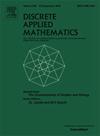广义竞争可定向完全多部图
IF 1
3区 数学
Q3 MATHEMATICS, APPLIED
引用次数: 0
摘要
我们说,有向图D是(i,j)步竞争性的,如果任意两个顶点在D中有(i,j)步共同外邻,那么图G是(i,j)步竞争性可定向的,如果存在G的(i,j)步竞争性可定向。在Choi et al.(2022)中,Choi等人引入了竞争性有向图的概念,并根据其部集的大小完全描述了竞争性可定向的完全多部图。这里,竞争有向图指的是(1,1)步竞争有向图。本文将Choi等人的结果推广到(i,j)步竞争可定向完全多部图的一般表征。本文章由计算机程序翻译,如有差异,请以英文原文为准。
Generalized competitively orientable complete multipartite graphs
We say that a digraph is -step competitive if any two vertices have an -step common out-neighbor in and that a graph is -step competitively orientable if there exists an -step competitive orientation of .
In Choi et al. (2022), Choi et al. introduce the notion of the competitive digraph and completely characterize competitively orientable complete multipartite graphs in terms of the sizes of its partite sets. Here, a competitive digraph means a -step competitive digraph. In this paper, the result of Choi et al. has been extended to a general characterization of -step competitively orientable complete multipartite graphs.
求助全文
通过发布文献求助,成功后即可免费获取论文全文。
去求助
来源期刊

Discrete Applied Mathematics
数学-应用数学
CiteScore
2.30
自引率
9.10%
发文量
422
审稿时长
4.5 months
期刊介绍:
The aim of Discrete Applied Mathematics is to bring together research papers in different areas of algorithmic and applicable discrete mathematics as well as applications of combinatorial mathematics to informatics and various areas of science and technology. Contributions presented to the journal can be research papers, short notes, surveys, and possibly research problems. The "Communications" section will be devoted to the fastest possible publication of recent research results that are checked and recommended for publication by a member of the Editorial Board. The journal will also publish a limited number of book announcements as well as proceedings of conferences. These proceedings will be fully refereed and adhere to the normal standards of the journal.
Potential authors are advised to view the journal and the open calls-for-papers of special issues before submitting their manuscripts. Only high-quality, original work that is within the scope of the journal or the targeted special issue will be considered.
 求助内容:
求助内容: 应助结果提醒方式:
应助结果提醒方式:


